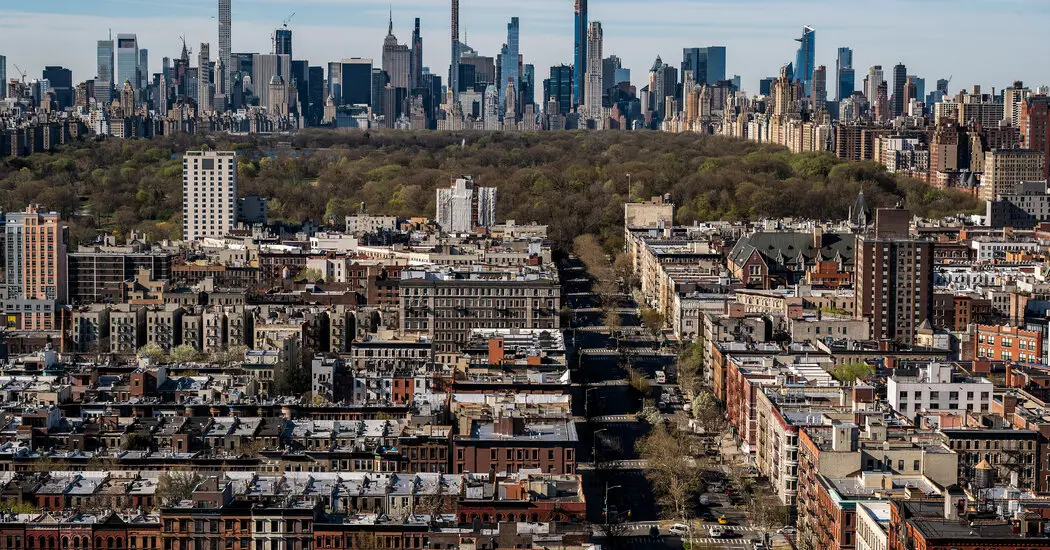News
New York Closes in on Housing Agreement to Address Affordability Crisis

New York state leaders have reached a deal on the framework of a legislative plan to address one of the worst housing crises in the nation, Gov. Kathy Hochul said on Monday.
The agreement was negotiated by Ms. Hochul and leaders in the Legislature, after a weekend of closed-door talks, and was presented to the full Senate and Assembly on Monday. Some lawmakers raised concerns about some of its critical elements — leaving open the possibility that parts of the deal might still change.
The agreement includes enticements for several major constituencies: tenants, labor unions and developers. For developers, the deal would include significant tax breaks that would make it more affordable to build. For tenants, it would include protections that would make it more difficult to evict renters in some apartments. Unions also ensured that the deal would include higher wages for construction workers.
It would also let landlords of rent-stabilized apartments increase rents to cover the cost of some renovations. And it would lift some size limits on new apartment buildings — a provision city officials have wanted for years.
Together, the measures are an attempt to tackle New York’s housing shortage by making it much easier to build, while also delivering new safeguards for tenants. The package, which is projected to yield tens of thousands of affordable homes in the coming years, is meant to be an urgent response to the worsening affordability problem in New York City and across the state that has been watched nationwide.
Ms. Hochul said while announcing the deal on Monday that getting to the agreement had “demanded unprecedented, all-consuming attention.”
“This is a landmark deal and I’m really proud of it,” Ms. Hochul said.
Despite the gathering momentum behind the package, left-leaning lawmakers are likely to find fault with the deal, whose tenant protections are not as sweeping as many had hoped for. On Monday, roughly 30 tenant advocates gathered at the Capitol to protest; several of them broke into a private Assembly conference to demand lawmakers reject the deal.
Last year Ms. Hochul proposed a wide-ranging plan to spur construction, but that plan failed after key players in the negotiations — the real estate industry, the left wing of the Democratic Party and labor unions — remained at odds.
But it appears the bleak situation in New York City has pushed all sides toward a compromise.
Development of new rental buildings in the city has all but stalled, evictions are ticking up and rents are poised to soar even higher as the summer approaches. An influx of migrants has overwhelmed New York City’s shelter system, and the number of available affordable apartments is functionally zero, according to the most recent city survey.
As part of the deal, lawmakers would trade a new developer tax break for broadened tenant protections — a key priority for the left wing of the Democratic Party.
Labor unions and the left agreed to support a new tax break package, known as 485x, that would apply more broadly than a previous tax break that expired, according to the people familiar with the negotiations. Left-leaning lawmakers had denounced previous versions of the tax break as overly friendly to corporate interests.
The deal would also lift restrictions on large apartment buildings, give developers incentives to convert vacant office buildings to housing and pave the way for more development statewide with tax breaks and incentives.
In exchange, tenant advocates would win protections that are inspired by a bill introduced unsuccessfully in previous years, known as “good cause eviction.” The measure would restrict the ability of landlords to evict tenants in many market-rate units. It would also prevent many landlords from removing tenants after a lease expires and would force them to justify rent increases beyond certain thresholds.
But according to people familiar with negotiations, the protections would apply only to apartments renting for less than certain levels: roughly $6,000 for a one-bedroom apartment in the New York City area, for example. It would not apply to tenants in buildings whose landlords have fewer than 10 units across their portfolios. New construction would be exempt for 30 years. The protections would apply automatically to New York City, but localities in the rest of the state would have to opt in.
An earlier, more expansive version of the measure that was proposed in the Legislature could have covered some 710,000 rentals in New York City, according to an analysis by the New York University Furman Center. But that was before applying many of the exemptions lawmakers have discussed as part of the package.
Officials could not provide a better estimate on Monday of how many apartments might be covered by a new measure.
Ben Carlos Thypin, the chief executive of Quantierra, a brokerage that tracks real estate portfolios, estimated that it could cover about 400,000 units, or about one-third of the city’s housing stock that is not already rent-regulated. But he said that the number could change depending on a number of factors, including how the bill is actually written.
The deal would loosen tenant-friendly laws passed in 2019 for landlords who invest in renovations of rent-stabilized apartments. Currently, landlords can only recuperate $15,000 worth of improvements on a single apartment through rent increases — a figure they say is inadequate to keep up with the necessary maintenance, particularly after long-term tenants vacate.
The changes would allow for more investments to be made the longer a unit had been occupied: up to $30,000 for an apartment occupied by the same tenants for more than 15 years, and up to $50,000 for apartments occupied for more than 25 years.
The result is an agreement that state leaders hope could make housing in New York less scarce and more affordable, stemming the exodus of families and people of limited means, and put the city and state economies on a more secure path.
Alicia Glen, a former deputy mayor for housing who helped negotiate housing packages during Mayor Bill de Blasio’s tenure, said the framework seemed like a good deal overall for New York.
“Everybody is going to be somewhere between a little unhappy and very unhappy,” said Ms. Glen, founder and managing principal at MSquared. “That’s the nature of the beast.”
That appeared to be true on Monday.
The Real Estate Board of New York, the influential lobbying group of the real estate industry, welcomed some pieces of the package, including the tax incentives for office conversions and lifting of restrictions on residential density.
But James Whelan, the group’s president, said in a statement on Monday that the new tax break for developers and measures designed to help owners of rent-stabilized units would not add up to the amount of housing the city and state need. He said that the “good cause eviction” component would “still create significant new risks for owners, developers and funders.”
“We are confident that this package falls far short of addressing the city’s housing needs and must be reassessed in the coming years to put the rental housing market on a solid footing,” he said.
Cea Weaver, the coalition director of Housing Justice for All, a tenant-advocacy group, called the deal a “sham,” saying that Ms. Hochul was “pushing through a housing deal written by the real estate industry.”
Dorca Reynoso, a renter who is on the board of the Metropolitan Council on Housing, a nonprofit group that advocates on behalf of tenants, was one of the protesters who broke into the closed-door meeting to tell lawmakers what she thought of the deal.
“It’s a crime what they are trying to do to tenants,” Ms. Reynoso said.
Mayor Eric Adams, for his part, applauded the deal on Monday.
“We are going to build our way out of this housing crisis and deliver a better future for all New Yorkers,” he said.
News
Further Support for Gravitational Wave Background in the Universe

The discovery of the gravitational wave background in 2016 marked a significant milestone in our understanding of the Universe. This groundbreaking discovery was further validated by the release of a second data set from the European Pulsar Timing Array, along with the addition of data from the Indian Pulsar Timing Array. These complementary studies have provided more evidence for the existence of the gravitational wave background, shedding light on the cosmic phenomena that shape our universe.
Gravitational waves are ripples in spacetime that are generated by violent processes such as merging black holes and colliding neutron stars. Predicted by Einstein in 1916 as part of his General Theory of Relativity, these waves have the ability to travel through space, largely unimpeded by any obstacles in their path. The first detection of gravitational waves in 2015 by the Laser Interferometer Gravitational-Wave Observatory (LIGO) confirmed their existence, originating from a gravitational merger between two black holes located 1.3 billion light years away.

The recent confirmation of the gravitational wave background by the European and Indian Pulsar Timing Arrays indicates that we are detecting a combined signal from the mergers of supermassive black holes. This random distribution of gravity waves that permeates the Universe offers a new avenue for studying the cosmos, akin to the Cosmic Background Radiation. The collaborative efforts of various observatories and research institutions have enabled us to delve deeper into the mysteries of the Universe.

Utilizing pulsar timing arrays as galaxy-sized detectors, researchers have been able to monitor and analyze the pulse arrival times of galactic pulsars on Earth. By detecting subtle patterns in these signals, they can uncover the presence of the gravitational wave background. The latest study led by J. Antoniadis from the Institute of Astrophysics in Greece delves into the implications of the low-frequency signals observed in the recent data releases from various pulsar timing array systems.
The accumulation of data from multiple sources has provided undeniable evidence for the existence of the gravitational wave background. With ongoing Pulsar Timing Array projects, the signals of the low-frequency gravity waves will become more distinct, offering a wealth of opportunities to explore the Universe in this novel way. The focus now shifts towards interpreting these signals to unlock the secrets of the cosmos.
-

 Entertainment1 week ago
Entertainment1 week agoOlivia Munn opens up about her decision to have a full hysterectomy during breast cancer fight: ‘It was the right choice for me’
-

 News1 week ago
News1 week agoUniversity of Wisconsin-Milwaukee and Protesters reach an agreement to dismantle encampment
-

 Entertainment2 days ago
Entertainment2 days agoSimone Biles Emerges Victorious over Suni Lee and Gabby Douglas at Gymnastics Classic
-

 News2 days ago
News2 days agoFacing Criticism for Shooting Dog, South Dakota Governor Noem Discusses ‘Difficult Choices’
-

 Business14 hours ago
Business14 hours agoWho are Crypto Market Makers and Market Takers?
-

 News16 hours ago
News16 hours agoFurther Support for Gravitational Wave Background in the Universe
-

 Entertainment15 hours ago
Entertainment15 hours agoCourteney Cox Reveals Late ‘Friends’ Co-Star Matthew Perry Continues to ‘Visit’ Her Even After His Passing










